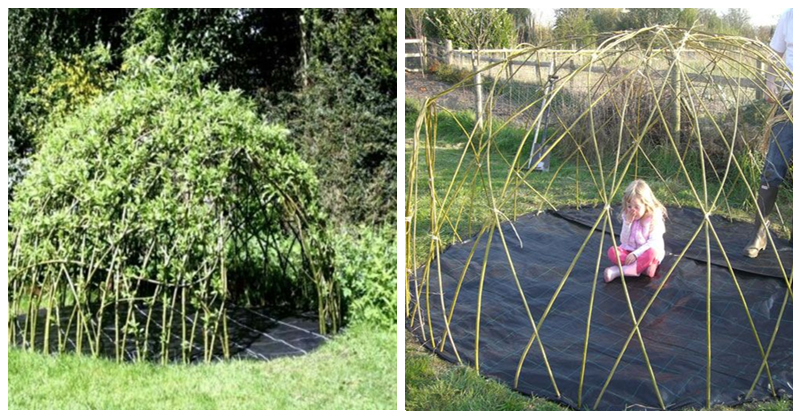When we were young, outside wasn’t just the best option, it was the only option. It was the only option I considered anyway. Still years away from home computers and social media, we had marbles, toy cars, and adventures. To make it to an unknown plot of forest was equivalent to a brand new adventure of at least the entire day. Maybe two, if we were lucky.
Society’s shift has been clear and it’s a shift indoors. Hidden behind screens and doors, our kids need to get back into the world. Just a trip to the garden is enough of an invitation to learn something about the world. Get your kids outside by becoming Mother Nature and growing a living playhouse your kids will love, and learn from.
The Runner Bean “Teepee” Den
This one is probably the easiest of all the playhouses to create, plus one that will give you some tasty runner beans for the whole family to enjoy throughout the summer season.
What You Need:
1) 8 – 10 long bamboo canes (6 – 7 feet minimum).
2) Gardening string or a cable tie or similar.
3) A packet of runner bean seeds.
4) Large roll of gardening string or a roll of chicken wire (optional).
Method
1) Choose a spare area of garden, either on a border, or on the lawn. You’ll have to remove a small area of lawn to plant the seeds.
2) Push your bamboo canes into the ground in a circle to form a large pyramid/teepee shape. Leave a large gap between two of the canes for an entrance. Secure the tops of the canes together using either a some garden string, twine, or wire.
3) For best results cover bamboo teepee in either chicken wire, or a network of gardening string.
4) Dig one square foot (12?x 12? and 12? deep) around the bases if the bamboo canes.
5) Add compost and/or well rotted manure.
5) Poke two holes approximately 1 – 2? deep at the base of each cane.
6) Drop one runner bean seed into each hole and fill the hole with water. Once the water has drained away gently drag soil back over the holes and then water again thoroughly. (Runner Beans seeds can also be started off in 3? pots and transplanted when they reach about 6? tall).
NOTE: You’ll need to protect the seedlings from slugs by manually removing the slugs every evening until the bean plants are about 6? tall.
7) If the Runner Beans don’t find the bamboo naturally you can carefully wrap the main shoots around the first part of the bamboo canes or chicken wire until they begin to climb on their own.
8) Keep weeds down and moisture in using lawn mowings or bark chips around the fresh Runner Bean plants. Water frequently.
Now you and your children can watch their playhouse come to life and grow up all on its own. The beans grow quickly, giving new lessons and questions every day.Your kids will love the fun of harvesting their own beans, and how pretty the playhouse will look covered in the delicate red flowers that runner beans produce. Remember to keep harvesting the beans regularly; this encourages the plants to continue flowering.
Start growing early and this playhouse will last most of Spring to the end of the Summer.
The Willow Den
This playhouse is more permanent, so select your location carefully. This playhouse is best built on moist soil because willow roots like moisture.
You will need:
1) A large bundle of long green willow rods about 6ft long.
2) Straw, for the base. This needs to be changed regularly. (Alternatively, you can use a natural weed suppressing material, like jute/hessian weed control mats.)
Method
1) First lay your straw or suppressing mat across the surface of the area you intend to grow your children’s playhouse.
2) Two and three year old rods are best for creating the base because of their height. Punch holes (approx 2 – 3? in diameter) through the areas in the straw or mat where your rods need to be planted. This creates the frame of your playhouse. Place the longest rods and tie the tops together, like a teepee. Don’t forget to leave space for an entrance.
3) Use the two year old rods as uprights and one year old rods as the diagonal weave.
The top of the den will be open at first. New growth will gradually close the gap, and can be woven and tied for winter maintenance in the following years.
I know we’re focusing on getting the kids outdoors, but by growing living playhouses that have no capability for TVs to be plugged in, or iPhones to be recharged, I think it’s a good start. Plus, they’ll learn a thing or two about the beauty of nature, without resorting to pictures from the internet…

If you like this idea, be sure to share it with your friends and inspire someone you know. Anything becomes possible with just a little inspiration…
